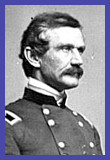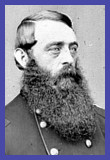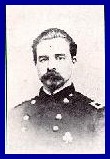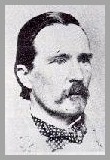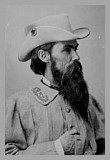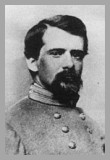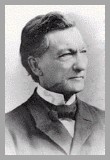| As winter
began to show signs of turning into spring, active
campaigning began to return to the lines around Richmond
and Petersburg. In February Grant ordered another attempt
made to turn the Boydton Plank Road lines projecting
southwestward from Petersburg. The impetus of this operation came from Union intelligence reports that wagon traffic on the Boydton Plank Road was heavy, thus a cavalry strike against that artery might reap substantial benefits. CONFIDENTIAL. CITY POINT, VA., February 4, 1865. Maj. Gen. G. G. MEADE, Commanding Army of the Potomac: I would like to take advantage of the present good weather to destroy or capture as much as possible of the enemy's wagon train, which it is understood is being used in connection with the Weldon railroad to partially supply the troops about Petersburg. You may get the cavalry ready to do this as soon as possible. U.S. Grant, Lt. General Accordingly, Gregg's Second Cavalry Division was ordered to take a roundabout route from Ream's Station to Dinwiddie Court House to reach the Boydton Road, and capture or destroy any and all enemy wagon traffic that was found. To support Gregg and take advantage of any Confederate responses were II Corps (now commanded by Maj. Gen. A.A. Humphreys), which was to again take up a position along Hatcher's Run, and V Corps, which would be further south. Recent intelligence indicated that the Rebel cavalry division of M.C. Butler had been sent to defend South Carolina, which would leave Lee with only a single mounted division (commanded by his son, Rooney) to oppose Gregg. Gregg moved out promptly on the morning of Feb. 5th and reached the Boydton Road on Feb. 6th, but found it virtually deserted. After scooping up a few prisoners and destroying about 18 wagons, he was ordered to withdraw and fall back on the supporting infantry. On the 5th, Humphreys had taken two divisions of II Corps out from behind the Federal lines to deploy and intrench within about 1,000 yards of the main Rebel line in the vicinity of Armstrong's Mill, a bit to the west of the Vaughan Road crossing of Hatcher's Run. Humphreys's line was thus facing north and the opposing Rebel line was facing south. Late that afternoon, Heth made a spirited attack on Smyth's division of II Corps, but was driven off. One division each from IX and VI Corps were sent to reinforce Humphreys. Warren, with V Corps, had deployed to the south of Humphreys, facing west and slightly south, along the banks of Gravelly Run. Together the two Union corps formed a bulge projecting westwards, with II Corps holding the northern side of the bulge and V Corps holding the western and southern sides. It is apparent from the message traffic that Meade had no confidence in the operation and was afraid of another disaster to his army. He therefore ordered the entire expedition to concentrate near Humphreys's position along Hatcher's Run. On the morning of the 6th he wanted all three of his commanders to probe outwards from their lines to determine where the enemy was and what his intentions were. Along the front of II Corps it quickly became apparent that there was little prospect of action. Federal patrols encountered virtually no Rebels except skirmishers in front of the enemy works. Warren was late getting started because he had not understood Meade's orders to mean that he was supposed to actually do anything. (His lengthy and confused explanation of this in the OR is a masterful revelation of Warren's own command inadequacies.) At about 1:15 he finally got one of his divisions moving westward along the road towards Dabney's Mill. At the same time Gregg's cavalry would be probing southwards along the Vaughan Road. On the other side of the trenches, orders were issued for Mahone's men to return to the main trenches, while Pegram's division reconoitered between the Boydton Plank Road and the Vaughan Road. Evans would hold the line along Hatcher's Run. Contact between Pegram's troops and the Federals was made at about 2:00 p.m. On the Federal left, the cavalry under Gregg were hard-pressed until an infantry brigade was dispatched to their support by Warren. On the Federal right, the fight became more serious. At first, Warren's troops --- Crawford's Division, 3/V --- were able to press Pegram's men back towards Dabney's saw mill. But the advance was causing Crawford's men to waver some, and when fresh Rebel troops appeared (Evans's division, shifting over to the sound of the fight), the Yankees were driven back in some disorder. A couple of brigades from Ayres's Federal division restored the line, but then Mahone's men showed up to hit the still-unsteady Federals with a hard counterattack. Both Crawford and Ayres were forced back, losing some men as prisoners, before the arrival of more Federal reinforcements (Griffin's V Corps division and Wheaton's VI Corps division) stopped the Rebels. With nightfall coming early, the battle sputtered out without much conclusion. On the 7th, Warren had Crawford advance again to recover the lost ground, which he was able to do against very light resistence. Soon thereafter the Federal expedition was recalled. Casualties were light. Federal losses were around 1,500, total. Confederate losses are estimated at around 1,000, although Humphreys thought he inflicted that many casualties on Heth's Feb. 5th attack, alone. Among the Confederates killed on Feb. 6th was Gen. John Pegram, recently married, who was killed in some of the last fighting near Dabney's saw mill. The Yankees connected part of their new line to the old one, giving them a solid line of entrenchments running all the way from the Appomattox River to Vaughan Road along Hatcher's Run. Although the operation had not attained its stated purpose --- the destruction of the Rebel wagon trains --- and had failed to inflict a serious defeat on the Confederate infantry, it had resulted in yet another extension of the Federal siege lines, making Lee's task of holding Petersburg and Richmond just that much harder. The return of good weather and hard roads could not be a good sign for the Confederates. |
|
|||||||||
|
Return to Siege main page. Return to list of accounts. Go to previous page. Go to next page. |

